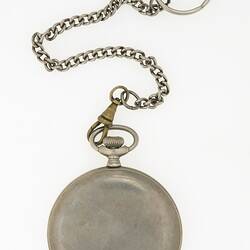Summary
Alternative Name(s): Pocket Watch
Fob Watch with raised numbers and numbers in braille. It was probably made during the mid to late nineteenth century and would have been used by a blind or partially-sighted person to tell the time.
Braille was first developed in 1825 by Louis Braille, a blind Frenchman. He spent several years refining his system and in 1829 published 'Method of Writing Words, Music, and Plain Songs by Means of Dots, for Use by the Blind and Arranged for Them.' In 1854 braille was adopted as the official communications system for blind people in France and in 1870 for Britain.
Physical Description
Metal round fob watch with metal cover and chain. The face of the watch is raised and recessed, with braille numbers raised to show the hours, and Arabic numbers also raised slightly. The hands of the watch are of brass; a link between the watch and the chain may be gold-plated; the rest is Britannia metal, a type of pewter alloy.
More Information
-
Collection Names
-
Collecting Areas
-
Acquisition Information
Donation from Royal Victorian Institute for the Blind (RVIB), 21 Jul 1993
-
Date Made
circa 1850-1900
Probably, based on the style, a mid to late nineteenth century example. -
Previous Owner
-
Inscriptions
Numbers in braille and Arabic 1 - 12 around the watch face.
-
Classification
Medicine & health, Health organisations, Special needs equipment
-
Category
-
Discipline
-
Type of item
-
overall dimensions
5 cm (Length), 0.5 cm (Width), 8 cm (Height)
-
Keywords
Disability Organisations, Time Keeping, Visual Impairment, Braille, Horology







